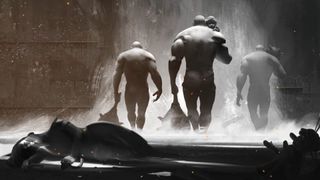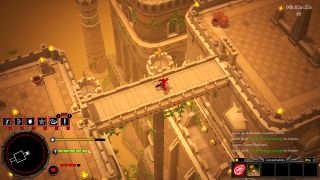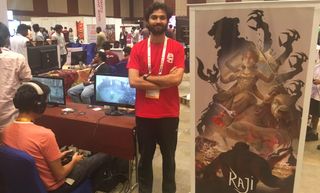Indie developers in India are channeling their history into exciting new games
Every year the Nasscom Game Developers Conference gets bigger. Here are six exciting PC games from this year's show.

When you consider that the very first videogame company in India was only established in 1997 (Dhruva Interactive, which would eventually work on games in the Forza and Need For Speed series), it's surprising the country has anything resembling a games industry. To be just kicking things off in 1997 puts India around 25 years behind countries like the US and the UK.
This only serves to make the country's small but growing industry—and particularly its vibrant indie scene—more impressive. I've gone to the Nasscom Game Developer Conference, India's biggest games industry event, for the past three years, and it feels like the developers there are making up for lost time.
Each year the quality of the games I play increases more dramatically than you'd think possible. And one of this year's major developments seemed to be that, after a few years of nearly every Indian developer making games for mobile, interesting projects are now cropping up on PC.

A notable example of one that's actually launched is Asura, a hack-n-slasher set in a world inspired by Indian mythology, developed by the studio Ogre Head, which won the Nasscom Game of the Year award.
The vast majority of India's most intriguing PC games are still in development. After going hands-on with a number of them at Nasscom Game Developer Conference 2017, here are the Indian-developed PC games you should be excited about.
Mukti

Mukti is "a mystery exploration game" according to its creators, collaborating Mumbai-based indie developers Wandermind Labs and underDOGS Studio. What this means is that its puzzles aren't obscure enough to be a full-fledged point-and-click adventure game, but provide more to mull over than the average walking simulator.
It's part of what seems to be a growing trend of indie games from India that are actually set in the country, which is cool to see. It begins with player character Arya returning to India to visit her grandfather Vikram Roy, a famed expeditionist and historian, at the Mumbai museum he owns.
The biggest gaming news, reviews and hardware deals
Keep up to date with the most important stories and the best deals, as picked by the PC Gamer team.
When she arrives, her grandfather is notably absent and there's a breaking news story that he and his crew are guilty of murdering an entire tribe on an excavation in West Bengal, making off with the artifacts they were protecting.
There's something evocative about museums after hours, and Mukti captures that as Arya searches the sprawling building—from shadowy back rooms to imposing exhibits, each focusing on a different aspect of Indian history—for answers.
The game's developers are unashamedly inspired by Gone Home, and early impressions suggest that Mukti could capture something of that eerie, unsettling experience of uncovering long-hidden secrets through exploration. Mukti won this year's Upcoming Game award.
Raji: An Ancient Epic

Considering that Raji: An Ancient Epic has been in development by a team of just eight people over a period of 10 months, it has absolutely no right to look or play as brilliantly as it does. By far the best-looking and most polished game at the conference, it's an action game that channels God of War but with a distinctly Indian flavor.
The premise is that Raji, a young girl, is imbued with elemental powers and chosen by the gods to defend humanity from an onslaught of demonic creatures. Everything, from the environments to the demons themselves, are inspired by Ancient India, and painstakingly hand-painted.
Raji doesn't reinvent the wheel—the standard enemy encounter goes something like: roll to dodge incoming attacks, attack with combos when the opportunity arises, hit button prompt to activate finishing move when sufficiently weakened—but Raji's combat has weight and impact that indies often struggle to capture. Plus, you can throw spears around, which is surely one of the most satisfying ways to take out an enemy in a game.
Having already taken on a massive challenge in creating an action game with a small team and limited resources, the developers are aiming to create a single-player experience that clocks in at around four hours long. That sounds like the sweet spot for this kind of game, and my early experiences with it have more than convinced me that the developers could cram an exciting and varied campaign into this time—though right now that hope rests on there being a positive outcome to its Kickstarter campaign.
Alter Army

Alter Army is a game that's garnered some attention simply by virtue of the fact that its development duo are 15 and 16 years old respectively. The unerring focus of the pair, who presented the game to me with the same excitement and vigour in both 2016 and 2017, is genuinely inspiring.
But what we shouldn't lose sight of is that the game itself has plenty to recommend it. A 2D beat-em-up starring four playable characters (through I only got the chance to play as one), Alter Army deliberately puts you in manic situations, hems you in with enemies of varying strengths and attack styles, then gives you the fluidity of control to emerge unscathed.
Alter Army's coolest feature is its risk-versus-reward Aggression System, which rewards gung-ho attacks with faster healing, more damage, and faster movement at the increased risk of getting scythed down.
It's also hard as nails. When I played it on the expo floor I was told that I was the only person all day to get past the first level. On one hand I could well believe that, as the level was certainly no walkover, but on the other it's extremely rare for me to be the best gamer in any given room. It's possible that I was condescended to by a 15-year-old is what I'm saying.
Possessions

After repeatedly dying in Alter Army, Possessions was just the tonic. A gentle puzzle game with a relaxing—albeit, in this early version, ever so slightly repetitive—soundtrack, each level presents a diorama-esque view of a room in which at least one element is out of place.
Maybe it's a shirt floating in mid-air rather than being hung on the rail, a framed photo on a random patch of wall rather than its rightful place among an arrangement of others. By dragging the mouse to shift the perspective, players can find the angle that restores order.
This little mechanic would be satisfying enough, but there's added intrigue in the fact that certain choices you make (occasionally, more than one item can fit into a single space) end up having consequences in the composition of future scenes, contributing to a kind of wordless narrative. How that manifests itself will be fascinating to see when Possessions is out next year.
The Bonfire: Forsaken Lands

Boil them down and nearly all videogames are about systems that at first offer the player a very narrow selection of interactions, and continually broaden that offering as they progress. The text-based game A Dark Room exposed this, its first (and only) option being to light a fire before a number of other options begin to appear in increments.
The Bonfire: Forsaken Lands takes A Dark Room as its principal inspiration, but brings a minimalist art style rather than relying purely on text. Set in a snowy encampment, with a five-minute day/night cycle neatly suggesting the passage of time, the aim is to spend the days gearing up in preparation for the nightly attacks from various beasts.
Like A Dark Room and other games in its mold, things start off incredibly simple. But before you know it, you're assigning workers to various roles, crafting and equipping them with task-appropriate tools, and even sending them off to discover new lands.
Death of a Detective
Considering how early in development Death of a Detective is, I shouldn't even be mentioning it here. After all, it requires a great deal of faith to label something "exciting" just from some artwork and a teaser, before anything playable has emerged.
However, the concept alone makes it worthy of a mention. It's a point-and-click adventure game with shades of Phoenix Wright, featuring a story told in the classic noir tradition and set in 1940s British India.
Little else is known about the game right now other than that it definitely won't be launching in 2017, so this one really could go either way. But for now, I'm going to stick my neck out and say that this Indian noir looks cool as hell.
Most Popular


